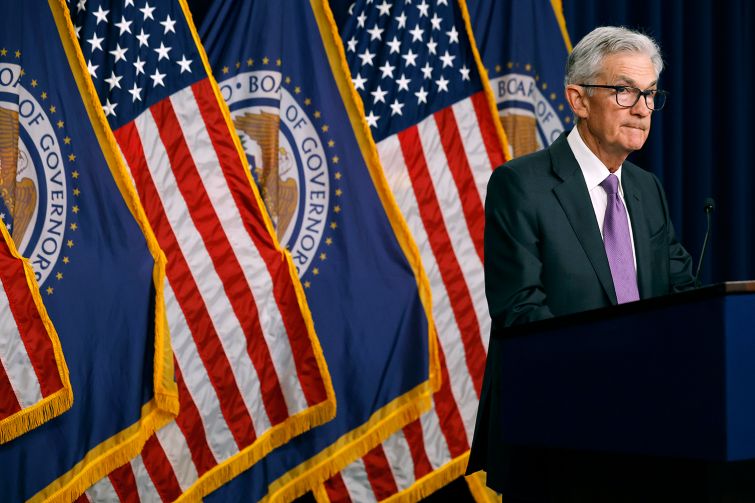Fed Holds Interest Rates Again, Says More Inflation Progress Needed Before Cuts
By Andrew Coen May 1, 2024 2:11 pm
reprints
The Federal Reserve as expected kept interest rates unchanged for a sixth straight meeting Wednesday while also signaling that potential cuts may not arrive as early as many in commercial real estate would like.
The central bank kept its benchmark interest rate at between 5.25 percent and 5.5 percent and said in its post-meeting statement that reductions would not occur until there is sufficient progress with shifting inflation toward the Fed’s 2 percent target. The Fed’s five straight interest rate pauses since September comes on the heels of 11 rate hikes in 12 meetings implemented from March 2022 to July 2023 to bring borrowing levels to their highest point in 22 years.
“Inflation is still too high,” Fed Chairman Jerome Powell said in opening remarks of his post-meeting press conference. “Further progress in bringing it down is not assured and the path forward is uncertain.”
Powell added that recent inflation readings have been above expectations and expects it to take longer than previously expected before the Fed gains confidence that inflation is on a sustainable path toward the 2 percent goal. He stressed though that the Fed’s next meeting in late June is “unlikely” to result in a rate hike.
Inaction on lowering interest rates during the first three Fed meetings of 2024 was not what was forecast in December when the central bank indicated in its post-meeting statement that three interest cuts were projected this year. There are five remaining Fed meetings this calendar year, and market participants have speculated that the Fed will not lower interest rates close to the presidential election in November.
Andrew Alperstein, real estate partner at PwC, described the start of 2024 as “bumpy” with little transaction activity after high hopes at the close of 2023 when the 10-year Treasury was below 4 percent with lender spreads going also going down given the expectations of multiple rate cuts this year.
“The optimistic view at the beginning of the year was that the availability and cost of debt was going to be more available and at a lower cost, and that hasn’t completely materialized in the way that they expected,” Alperstein said.“Our clients are generally cautiously optimistic because there is capital available and they have the ability to be patient, although that wears down a little bit as the months and quarters go by because you’ve got capital sitting there not earning as it should.”
Alperstein noted that while spreads have come down in the commercial mortgage-backed securities market, it has been largely offset by long-term Treasurys jumping more than 70 basis points this year to over 4.60 this week. He added that while a number of lenders have collaborated with borrowers to extend floating-rate loans with looming maturities, much of that cooperation was with the prospect of interest rates coming down and that cooperation could soon evaporate for some properties, especially in the office sector.
Jay Alexander, chief investment officer at Sagard Real Estate, stressed that the CRE market is overall better positioned to withstand increased debt costs than during the Global Financial Crisis of 2008, because only around 40 percent of investments are leveraged compared to 55 percent then. Alexander said Sagard’s portfolio is around 20 percent leveraged now, but noted that some of its assets with looming maturities have still needed extensions, and lenders have been accommodating with pricing that often equates to borrowing for a new loan depending on spreads.
“Most of what is going on is a workout discussion and collectively figuring out an extension option that works that may push through and does include higher rates,” Alexander said. “But it may get you to a period in a couple years where people are hoping rates will come in quite a bit.”
The Fed also announced Wednesday it would begin to slow the pace of its quantitative tightening bond holdings program starting in June by reducing the pace of its monthly redemption cap from $60 billion to $25 billion.
While most in the CRE industry are hoping interest rates will be lowered soon, some view the Fed’s hawkish policy as a long-term positive that can help expedite a reset in values for certain struggling assets, such as Class B office buildings.
Zhijun Yang, assistant professor of finance at the University of Pittsburgh at Johnstown, said he is in favor of the Fed’s direction the last two years and would even support more increases to combat inflation while also speeding up resolutions to distressed properties.
“Middle- or lower-end office properties were in trouble even before COVID, but now they are deeply in trouble because the market is trying to get rid of them or upgrade them,” said Yang, who specializes in studying CRE finance. “This type of Fed decision could add a little bit more speed to the transition process.”
Andrew Coen can be reached at acoen@commercialobserver.com


